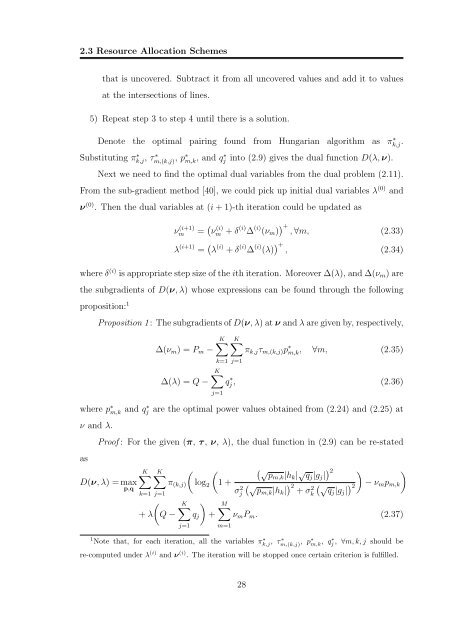Resource Allocation in OFDM Based Wireless Relay Networks ...
Resource Allocation in OFDM Based Wireless Relay Networks ...
Resource Allocation in OFDM Based Wireless Relay Networks ...
You also want an ePaper? Increase the reach of your titles
YUMPU automatically turns print PDFs into web optimized ePapers that Google loves.
2.3 <strong>Resource</strong> <strong>Allocation</strong> Schemes<br />
that is uncovered. Subtract it from all uncovered values and add it to values<br />
at the <strong>in</strong>tersections of l<strong>in</strong>es.<br />
5) Repeat step 3 to step 4 until there is a solution.<br />
Denote the optimal pair<strong>in</strong>g found from Hungarian algorithm as πk,j ∗ .<br />
Substitut<strong>in</strong>g πk,j ∗ , τ m,(k,j) ∗ , p∗ m,k , and q∗ j <strong>in</strong>to (2.9) gives the dual function D(λ, ν).<br />
Next we need to f<strong>in</strong>d the optimal dual variables from the dual problem (2.11).<br />
From the sub-gradient method [40], we could pick up <strong>in</strong>itial dual variables λ (0) and<br />
ν (0) . Then the dual variables at (i + 1)-th iteration could be updated as<br />
ν (i+1)<br />
m<br />
= ( ν (i)<br />
m + δ (i) ∆ (i) (ν m ) ) +<br />
, ∀m, (2.33)<br />
λ (i+1) = ( λ (i) + δ (i) ∆ (i) (λ) ) +<br />
, (2.34)<br />
where δ (i) is appropriate step size of the ith iteration. Moreover ∆(λ), and ∆(ν m ) are<br />
the subgradients of D(ν, λ) whose expressions can be found through the follow<strong>in</strong>g<br />
proposition: 1<br />
Proposition 1 : The subgradients of D(ν, λ) at ν and λ are given by, respectively,<br />
∆(ν m ) = P m −<br />
∆(λ) = Q −<br />
K∑<br />
k=1 j=1<br />
K∑<br />
π k,j τ m,(k,j) p ∗ m,k, ∀m, (2.35)<br />
K∑<br />
qj ∗ , (2.36)<br />
j=1<br />
where p ∗ m,k and q∗ j are the optimal power values obta<strong>in</strong>ed from (2.24) and (2.25) at<br />
ν and λ.<br />
as<br />
Proof : For the given (π, τ , ν, λ), the dual function <strong>in</strong> (2.9) can be re-stated<br />
D(ν, λ) = max<br />
p,q<br />
K∑<br />
K∑<br />
k=1 j=1<br />
(<br />
+ λ Q −<br />
π (k,j)<br />
(<br />
log 2<br />
(1 +<br />
K∑<br />
)<br />
q j +<br />
j=1<br />
σ 2 j<br />
(√<br />
pm,k |h k | √ q j |g j | ) 2<br />
(√<br />
pm,k |h k | ) 2<br />
+ σ<br />
2<br />
k<br />
(√<br />
qj |g j | ) 2<br />
)<br />
− ν m p m,k<br />
)<br />
M∑<br />
ν m P m . (2.37)<br />
m=1<br />
1 Note that, for each iteration, all the variables πk,j ∗ , τ m,(k,j) ∗ , p∗ m,k , q∗ j , ∀m, k, j should be<br />
re-computed under λ (i) and ν (i) . The iteration will be stopped once certa<strong>in</strong> criterion is fulfilled.<br />
28

















